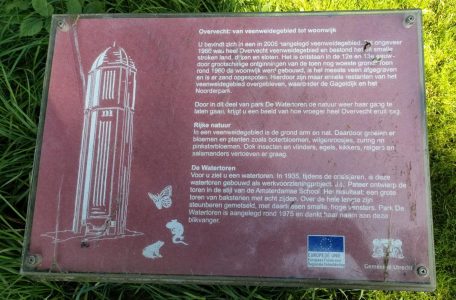Overvecht: from peat meadow area to residential area
You are in a peat meadow area that was created in 2005. Until about 1960, the whole of Overvecht was a peat meadow area and consisted of narrow strips of land, dikes and ditches. It originated in the 12th and 13th century through large-scale cultivation of the wild lands. When the residential area was built around 1960, most of the peat was excavated and sand was sprayed as toplayer. As a result, only a few remnants of the peat meadow area remain, including the Gageldijk and the Noorderpark.
By letting nature take its course again in this part of De Watertoren park, you get an idea of what the whole of Overvecht used to look like.
Rich nature
In a peat meadow area, the soil is poor and wet. As a result, flowers and plants such as buttercups, fireweeds, sorrel and cuckoo flowers grow. Insects and butterflies, hedgehogs, frogs, herons and salamanders also like to stay there.
The Water Tower
You will see a water tower in front of you. In 1935, during the crisis years, this water tower was built as a work provision project. J.L. Pateer designed the tower in the style of the Amsterdam School. The result: a large tower of bricks with eight sides. Buttresses are built along the entire length, with narrow, high windows in between. Park De Watertoren was built around 1975 and owes its name to this eye-catcher.

